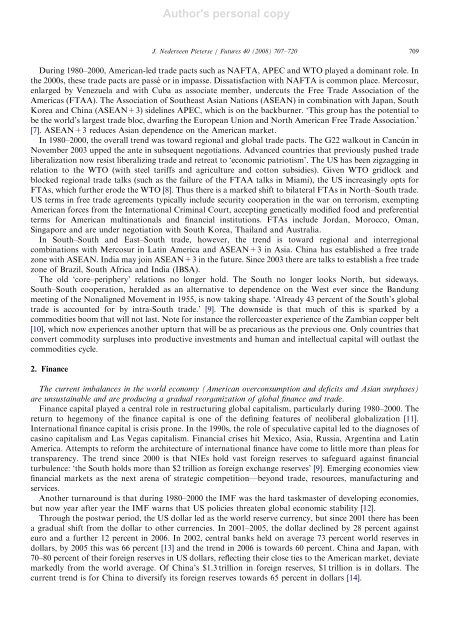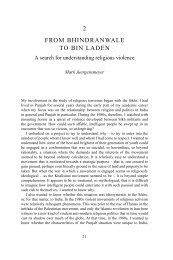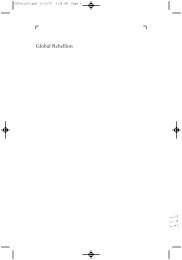New Glob Fu JFTR1275.pdf - Jan Nederveen Pieterse
New Glob Fu JFTR1275.pdf - Jan Nederveen Pieterse
New Glob Fu JFTR1275.pdf - Jan Nederveen Pieterse
Create successful ePaper yourself
Turn your PDF publications into a flip-book with our unique Google optimized e-Paper software.
Author's personal copy<br />
During 1980–2000, American-led trade pacts such as NAFTA, APEC and WTO played a dominant role. In<br />
the 2000s, these trade pacts are passe´ or in impasse. Dissatisfaction with NAFTA is common place. Mercosur,<br />
enlarged by Venezuela and with Cuba as associate member, undercuts the Free Trade Association of the<br />
Americas (FTAA). The Association of Southeast Asian Nations (ASEAN) in combination with Japan, South<br />
Korea and China (ASEAN+3) sidelines APEC, which is on the backburner. ‘This group has the potential to<br />
be the world’s largest trade bloc, dwarfing the European Union and North American Free Trade Association.’<br />
[7]. ASEAN+3 reduces Asian dependence on the American market.<br />
In 1980–2000, the overall trend was toward regional and global trade pacts. The G22 walkout in Cancu´n in<br />
November 2003 upped the ante in subsequent negotiations. Advanced countries that previously pushed trade<br />
liberalization now resist liberalizing trade and retreat to ‘economic patriotism’. The US has been zigzagging in<br />
relation to the WTO (with steel tariffs and agriculture and cotton subsidies). Given WTO gridlock and<br />
blocked regional trade talks (such as the failure of the FTAA talks in Miami), the US increasingly opts for<br />
FTAs, which further erode the WTO [8]. Thus there is a marked shift to bilateral FTAs in North–South trade.<br />
US terms in free trade agreements typically include security cooperation in the war on terrorism, exempting<br />
American forces from the International Criminal Court, accepting genetically modified food and preferential<br />
terms for American multinationals and financial institutions. FTAs include Jordan, Morocco, Oman,<br />
Singapore and are under negotiation with South Korea, Thailand and Australia.<br />
In South–South and East–South trade, however, the trend is toward regional and interregional<br />
combinations with Mercosur in Latin America and ASEAN+3 in Asia. China has established a free trade<br />
zone with ASEAN. India may join ASEAN+3 in the future. Since 2003 there are talks to establish a free trade<br />
zone of Brazil, South Africa and India (IBSA).<br />
The old ‘core–periphery’ relations no longer hold. The South no longer looks North, but sideways.<br />
South–South cooperation, heralded as an alternative to dependence on the West ever since the Bandung<br />
meeting of the Nonaligned Movement in 1955, is now taking shape. ‘Already 43 percent of the South’s global<br />
trade is accounted for by intra-South trade.’ [9]. The downside is that much of this is sparked by a<br />
commodities boom that will not last. Note for instance the rollercoaster experience of the Zambian copper belt<br />
[10], which now experiences another upturn that will be as precarious as the previous one. Only countries that<br />
convert commodity surpluses into productive investments and human and intellectual capital will outlast the<br />
commodities cycle.<br />
2. Finance<br />
ARTICLE IN PRESS<br />
J. <strong>Nederveen</strong> <strong>Pieterse</strong> / <strong>Fu</strong>tures 40 (2008) 707–720 709<br />
The current imbalances in the world economy (American overconsumption and deficits and Asian surpluses)<br />
are unsustainable and are producing a gradual reorganization of global finance and trade.<br />
Finance capital played a central role in restructuring global capitalism, particularly during 1980–2000. The<br />
return to hegemony of the finance capital is one of the defining features of neoliberal globalization [11].<br />
International finance capital is crisis prone. In the 1990s, the role of speculative capital led to the diagnoses of<br />
casino capitalism and Las Vegas capitalism. Financial crises hit Mexico, Asia, Russia, Argentina and Latin<br />
America. Attempts to reform the architecture of international finance have come to little more than pleas for<br />
transparency. The trend since 2000 is that NIEs hold vast foreign reserves to safeguard against financial<br />
turbulence: ‘the South holds more than $2 trillion as foreign exchange reserves’ [9]. Emerging economies view<br />
financial markets as the next arena of strategic competition—beyond trade, resources, manufacturing and<br />
services.<br />
Another turnaround is that during 1980–2000 the IMF was the hard taskmaster of developing economies,<br />
but now year after year the IMF warns that US policies threaten global economic stability [12].<br />
Through the postwar period, the US dollar led as the world reserve currency, but since 2001 there has been<br />
a gradual shift from the dollar to other currencies. In 2001–2005, the dollar declined by 28 percent against<br />
euro and a further 12 percent in 2006. In 2002, central banks held on average 73 percent world reserves in<br />
dollars, by 2005 this was 66 percent [13] and the trend in 2006 is towards 60 percent. China and Japan, with<br />
70–80 percent of their foreign reserves in US dollars, reflecting their close ties to the American market, deviate<br />
markedly from the world average. Of China’s $1.3 trillion in foreign reserves, $1 trillion is in dollars. The<br />
current trend is for China to diversify its foreign reserves towards 65 percent in dollars [14].





